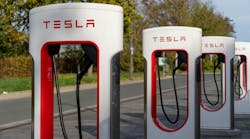Latest from Technology
Small Modular Reactors (SMRs) Presenting New Nuclear Option to Utility Market
With the thirst for electrical power that data centers, artificial intelligence and EV charging stations have, the need for new power sources is increasing and forcing an “all of the above” energy strategy that will blend conventional fossil fuels, renewables, load management and nuclear power.
Until fairly recently, you didn’t hear all that much about nuclear power figuring into the future U.S. energy portfolio. It had detractors because of concerns over storage of nuclear wastes and the nuclear accidents at Three Mile Island, Pennsylvania (1979); Chernobyl, Russia (1986) and Fukushima, Japan (2011).
However, there’s a lot of talk right now about SMRs (small modular reactors) a comparatively new way of producing nuclear power with much smaller reactors than conventional reactors. In the United States, 93 commercial nuclear reactors are operating at 54 nuclear power plants in 28 states, according to the U.S. Energy Information Administration.
SMR advocates say their reactors will be easier to produce and commission than earlier generations of nuclear reactors because they will be built modularly and be standardized units that can be linked together to produce the desired amount of power.
Wall Street investors are all over the SMR play and have driven up the stock prices for a number of early players in this market including Oklo (OKLO), which was started up by OpenAI’s Sam Altman; NANO Nuclear Energy (NNE); and Nusale Power (SMR). Electric utilities that have been in nuclear power for years are also now active with SMRs, including Constellation Energy (CEG) and Vistra (VST), and GE Vernova (GEV) is also developing SMRs.
Google recently signed a deal to purchased power from SMR developer Kairos Power, and Amazon recently announced it's investing in three companies developing SMRs: Energy Northwest, X-energy and Dominion Energy.
A privately held company grabbing headlines in the SMR world is TerraPower, which is building a 345MW Natrium SMR in Wyoming. TerraPower was founded by Microsoft’s Bill Gates in 2008 and uses molten salt to cool the reactor.
The International Atomic Energy Agency (www.iaea.org) says SMRs have a power capacity of 300 MW per unit, about one-third of the generating capacity of traditional nuclear power reactors. A post on the IAEA website said, “Many of the benefits of SMRs are linked to the nature of their design — small and modular. Given their smaller footprint, SMRs can be sited on locations not suitable for larger nuclear power plants.
“Prefabricated units of SMRs can be manufactured and then shipped and installed on site, making them more affordable to build than large power reactors, which are often custom designed for a particular location, sometimes leading to construction delays. SMRs offer savings in cost and construction time, and they can be deployed incrementally to match increasing energy demand.”
SMR developers may be able to tap into development funding from the U.S. Department of Energy, which recently opened up applications for up to $900 million in funding to support the initial domestic deployment of Generation III+ (Gen III+) small modular reactor (SMR) technologies.
According to a DOE press release, it estimates the U.S. will need “approximately 700 to 900 GW of additional clean, firm power generation capacity to reach net-zero emissions by 2050. ”
“Nuclear power is a proven option that could be deployed to meet this growing demand,” the release said. “In 2023, nuclear energy provided nearly half of America’s carbon-free electricity. Utilities are looking to extend the lifespan of current nuclear reactors; planning to uprate reactor capacity; reversing plans to close reactors; and even restarting formerly closed reactors. At the same time, they are earnestly exploring building new reactors to meet the fast-growing demand for carbon-free energy.
“SMRs offer the potential for greater modularity, more factory-style construction, and the ability to be matched with loads and scaled to meet demand.”
While it may be a while before SMRs provide sales opportunities to manufacturers, distributors, reps, and their customers it's a good time to start familiarizing yourself with this technology, because SMRs may eventually be a viable power option with a dramatic impact on the utility industry.









